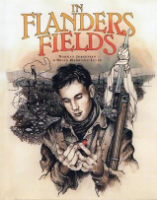In war it is the small acts of kindness that are often the most heroic and important as they serve as a counterpoint to the senselessness and inhumanity of war. ‘In Flanders Fields’ on Christmas Day a young soldier risks his life to enter no-man’s land and rescue a robin caught in the barbed wire that separates the two warring forces. As he walks, enemy snipers have him in their sights but they wait, puzzled. When the bird flies away ‘he whispers softly ‘Merry Christmas, little bird’ and we see a sniper whisper to himself, ‘Gluckliche Weihnact, Digger.’ As he returns, he can hear the German soldiers singing ‘Stille nacht, heilige nacht…’ and as he reaches his trench the carol continues ‘all in calm, all is bright’, a poignant reminder of their common humanity.
Brian Harrison-Lever’s pen and ink illustrations, rendered in mostly black and brown, capture a harsh and squalid landscape damaged by the constant shelling. The only colour comes from the fire in the trench and the bright red of the robin’s breast. Extensive study of WW1 photographs allowed Harrison-Lever to create accurate depictions of the primitive conditions in the trenches and the ugliness of no-man’s land. The endpapers again reflect the calamity of war. The front papers depict the view of inside the Australian trenches and the back cover repeats the scene in reverse with a perspective of the German trenches.
WW1, the Great War, or the supposed War to End all Wars, saw the death of some 20 million people and a similar number were wounded, many permanently. WW1 wrought profound changes to the political landscape in Europe, the destruction of empires, the creation of new nation-states and the growth in colonies of independence movements. It also ultimately led to the rise of Nazi Germany.
The inclusion of the words of Canadian John McCrae’s famous poem ‘In Flanders Field’ is a further reminder of the waste and senselessness of war.

